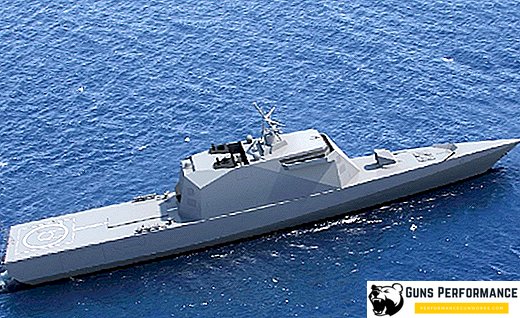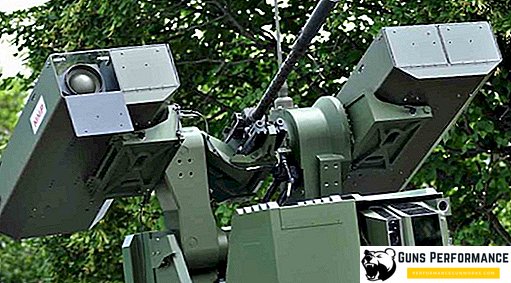Under the conditions of the total domination of the American fleet in the seas and oceans, the USSR Navy needed to take adequate steps all the time, eliminating a possible threat. It was necessary not only to preserve parity on nuclear submarines on which nuclear missiles were deployed, but also to have effective means of counteracting the strike forces of the fleet of a potential enemy. After a long search for an effective means of anti-submarine warfare, it was decided to build multi-purpose submarine submarines of the project 971.

The new ships were supposed to covertly conduct underwater reconnaissance, controlling the movements of submarine missile carriers of western countries, and, if necessary, act in advance.
How to create a new submarine "Pike" project 971
It should be noted that the idea to create a submarine capable of effectively fighting at sea with submarines of a potential enemy appeared immediately after the entry into service of the American fleet of Los Angeles-class submarines. The submarines available to the Soviet fleet were not very suitable for searching for enemy ships in the depths of the world ocean. The main disadvantage of the Soviet submarines of the second generation was the large noise of the underwater course. This was particularly reflected in the combat capability of the Soviet submarines, which could no longer compete on equal footing with the 3rd-generation submarines that appeared in foreign fleets.
Project 971 was a continuation of the practical implementation of the construction of titanium nuclear attack submarines of project 945. The main objective of the project was to expand the scale of construction of cheaper multi-purpose submarines. The basis of the new project was taken as the main components and aggregates of submarines of the 945 project. Instead of the titanium hull, new submarines should have steel hulls of similar form, similar tactical and technical data, including autonomy and range. The speed, depth and armament of the submarine of the project 971 should have similar parameters. Special emphasis in the project 971 was made on a significant reduction in the noise of the boat. This factor was to play a key role in the subsequent operation of the new class of submarines.

Project 971 submarine received the code "Pike-B", thus repeating the glorious combat history of "pikes", medium submarines from the Second World War. The design documentation provided for the construction of multi-purpose submarines of the 3rd generation with a large series, which the fleet had to replace outdated boats of the Pike type 671 project. The technical task for the new Pike appeared in the summer of 1976. A year later, the new submarine received its shape through the efforts of SKB-143 Malachite. This design bureau had already had experience building ocean submarines, so the Gorky project did not have to be customized for new factory conditions.
Only in 1980 were the last technical improvements completed and the production documentation was compiled. In 1983, the first submarine of the project 971 was laid, which received the ominous name "Shark". The submarine was supposed to initiate a large series of multi-purpose submarines with improved seaworthy and sonar characteristics.
Stages of construction of new submarines "Schuka"
The situation that developed in the mid-80s at sea forced the Higher Naval Leadership of the country to exert all efforts to increase the combat capability of the ocean submarine fleet. Tasks aimed at lowering the noise level of the course and increasing the firepower of submarines formed the basis of the new project. The first submarine received the factory number number 501 and was laid on the shipyard them. Lenin Komsomol in Komsomolsk on the Amur. In the summer of 1984, the ship was launched and under the new, 1985 entered service.

All subsequent ships of the new series, multipurpose submarines Shchuka-B of project 971 were simultaneously built on two shipyards of the country, in Komsomolsk on the Amur and on the Sevmash in the city of Severodvinsk. In total, 15 ships were launched, 8 of which were part of the Pacific Fleet, and the other 7 were the strike core of the Northern Fleet.
The first ship of the series, the submarine "Shark" in the first voyage showed unique results. The Soviet submarine surpassed its direct rival, the American nuclear submarine "Los Angeles" by the noise of the underwater course.
For reference: The secret of the success of the Soviet designers and shipbuilders was a new method of processing screws. For the first time in shipyards engaged in the construction of submarines, was used high-precision foreign equipment - Japanese milling machines brand "Toshiba". As a result, it was possible to significantly improve the quality of metalworking of the blades of the screws of the underwater ship, which was reflected in a decrease in the noise level of the rotating screw.
Project 971, according to the Western classification "Akula-II", became an unpleasant surprise for the American naval forces. From now on, American strike submarines and missile-carriers could not freely sail near the Soviet shores. Each movement of a submarine of a potential enemy was controlled by Soviet new “pike”.
At the government level, it was decided to give the new ships names that are consonant with the names of Soviet cities. For example, the sixth atomic submarine of the Shchuka-B type received the name Magadan after launching. However, after three years, the submarine received a new name, K-331 "Narval". With this name, the ship sailed until January 2001.
All nuclear submarines of the “Pike-B” type, which were commissioned in the Far East, were named after Russian cities in the Pacific Fleet. So, after the Akula submarine, the lead ship of the Project 971, the Far Eastern shipbuilders followed the Barnaul nuclear submarine and in 1989 the Bratsk submarine. Then came the turn of the Magadan nuclear-powered icebreaker, which was launched in December 1990. After the collapse of the Soviet Union, in 1992, the Kuzbass submarine multipurpose submarine entered the Pacific Fleet. Launched in 1993 on the stocks in Komsomolsk on the Amur, the submarine K-419 "Samara" was already being completed to replace the Soviet era. Submarine entered service in July 1995.
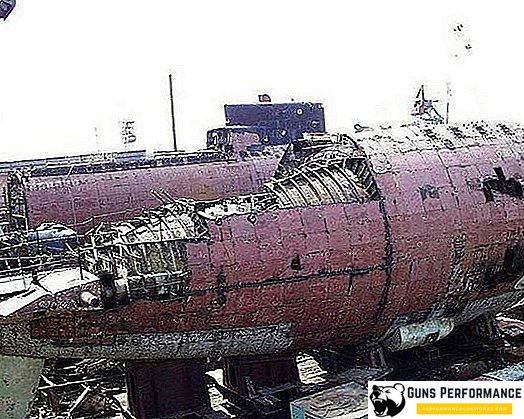
The only ship that stood out among the squadron of new ships was the KS 322 submarine Kashalot, which entered service in the Pacific Fleet in 1988.
Having received the first real confirmation of the correctness of the chosen technical solutions as a result of the implementation of the project 971, the construction of the Shchuka-B type submarines at the Severodvinsk machine-building enterprise was actively developed. Sevmash has become home to most Soviet nuclear-powered ships. The fate of the second series of Project 971 boats, assembled at the Sevmash shipyards and commissioned by the Northern Fleet, was no exception.
Design features of nuclear submarines of the project 971
Submarines of Project 971 were originally built as fighters of enemy submarine missile carriers, so powerful weapons were installed on ships. In terms of combat potential, modern "Pikes" are significantly superior to all domestic counterparts and were much stronger than foreign combat submarines of a similar class.
Together with the Barrakuda-type submarines, the new strike nuclear submarines were supposed to form the backbone of the USSR Navy to counteract the strike forces of the potential naval forces on the northern and eastern flank. Using their high tactical and technical characteristics, secrecy and greater autonomy, the new “Pikes” could be successfully used to conduct special operations throughout the entire ocean area.
Nuclear submarines had to be armed with new cruise missiles “Granat” and a digital hydro-acoustic complex.
The main design features of the nuclear-powered project 971 were to fully automate the main technological and combat processes. All control of the ship was concentrated in a single main command post. The system for automating the processes and control of the ship allowed a significant reduction in crew on the Pikes of Project 971. The fighting ship served 73 sailors and officers, which is almost two times less than on the main multipurpose nuclear submarine of the US Navy of the Los Angeles type. The conditions of dwelling of the personnel have increased on the new ships, the living conditions for the crew staying at sea for a long time have improved.
One of the innovative solutions applicable in the design of the ship, can be called the organization of the system of saving the crew of the ship in emergency situations. Boats of the "Shchuka-B" type were equipped with a pop-up rescue chamber, designed for the entire crew (73 people).
The hull and power plant of the nuclear submarine "Pike"
The first nuclear-powered projectile of Project 971 of the Pike-B type belonged to double-hulled ships. The main solid hull of the ship is steel, made of high-strength steel. The hull of the boat was divided into compartments in such a way that all combat posts and the main control points of the vessel were located in separate isolated zones. The inner part of the boat had a frame, typeset construction with transitions and decks. Due to the two-stage damping of each unit, it was possible to achieve a significant reduction in production noise and reduce the acoustic signal emitted by the working mechanisms and crew. Each unit in the ship was isolated from a sturdy hull with pneumatic shock absorbers, creating a second level of vibration isolation.
For example, on the submarine of the Northern Fleet K-317 "Panther", rubber shock absorbers and silicone gaskets on the main working mechanisms were tested for the first time. As a result, the noise of a working steam turbine installation of a nuclear reactor and electric motors decreased by 30-40%.
On all subsequent ships descending from the Sevmash stocks, parts and mechanisms made of synthetic materials were installed. Indicators of the noise produced by the submarines of the Northern Fleet of Project 971, and today remain the lowest.
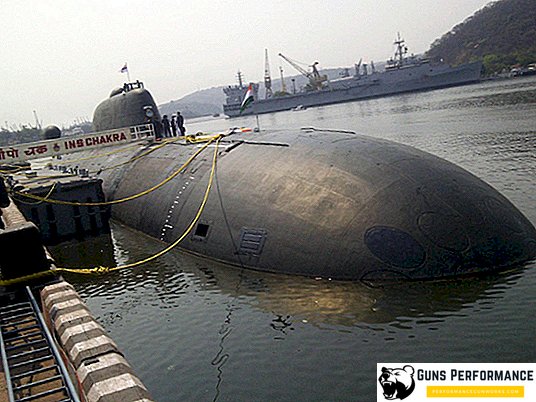
During the construction of boats, the technology of block assembly of the main ship structures was applied. Installation of equipment is now carried out not in the cramped conditions of the boat hull, but directly on the stands in factory workshops. Upon completion of the assembly, the unit was installed in the ship hull, after which it was connected to the main communications of the boat. Innovations made to the project, the presence of a rescue chamber for the crew and the hull made of high-strength steel led to an increase in the ship's displacement to 8 thousand tons.
For reference: the original design displacement of the submarine was 6-7 thousand tons, however, subsequent changes led to the weighting of the ship in the equipped state.
The propulsion system and the power supply system of the ship was based on the operation of one atomic reactor OK-650B, which communicated with four steam generators. As a backup power unit, a single-shaft steam turbine was installed on the boat, which had a full backup set of mechanization of all processes. The total power of the power plant is 50 thousand hp. As a result, the nuclear-powered vessel could develop a surface speed of 11 knots, and under water, at least 33 knots.
A seven-blade screw with improved hydrodynamics was driven by two electric motors.
The backup power plant consisted of two diesel engines DG-300, which provided electricity and the course of the ship in emergency situations. The stock of diesel fuel was designed for 10 daily sailing on backup engines.
Ship armament and navigation equipment
All the first boats of the series were produced with mine-torpedo armament and were equipped with the RK-55 Granat missile systems. Torpedo armament consisted of 4 533 mm torpedo tubes, 4 TAs of 650 mm caliber. The main difference between the new class of submarines was the universality of weapons. Rocket complex "Granat" allowed to fight with all types of naval weapons. Mine-torpedo group was responsible for anti-submarine defense. Cruise missiles and rocket-torpedoes were launched through underwater torpedo tubes from any position of the ship.
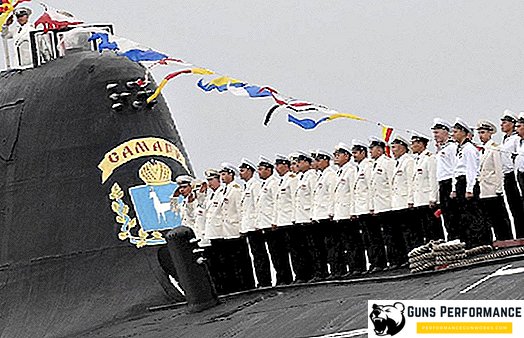
Project 971 submarines "Wolf" and "Leopard", which served in the Northern Fleet, as well as their counterparts in the Pacific Ocean carried new sonar systems "SKAT-KS". Basic information was processed by digital methods. In addition to the SCAT hydroacoustic complex, the new submarines were equipped with a unique system for detecting enemy ships along the wake.
From the beginning of the 90s, new navigation equipment was installed on the "Pikes". The submarine K-154 "Tigr" was recently modernized and is considered a ship with increased secrecy among Western experts. The submarines "Vepr" and "Samara" are currently undergoing modernization of the propulsion system and retrofitting with new hydroacoustic equipment. The ships are equipped with the new Medveditsa-971 navigation systems and the Symphony space radio communications complex.
Today, all ships of Project 971, which stand in the ranks of the Northern and Pacific Fleet, have been reequipped on Caliber missile systems. Some boats have been upgraded. The submarine K-328 Leopard, as well as the nuclear-powered K-461 Volk, went through a cardinal modernization and are again in the ranks. Atomic ships later release, the submarines K-335 "Cheetah", K-317, K-154 are currently considered the main ships of the Northern Fleet.
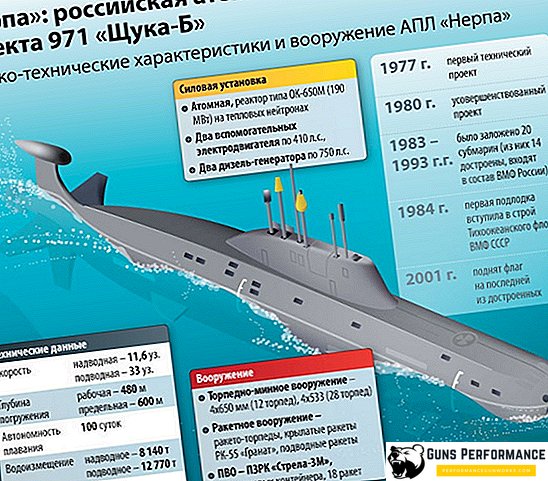
In the Pacific, only one K-419 Kuzbass submarine remains in service. The latest K-152 Nerpa, due to insufficient funding, was leased to the Indian Navy in January 2012.
Conclusion
The appearance at sea of new Soviet nuclear submarines of the Shchuka-B type came as a surprise to the fleets of western countries. From that moment on, American submarines lost their ability to secretly explore in the waters of the Northern Seas and in the Pacific Ocean. The collapse of the Soviet Union prevented the massive construction and deployment of new nuclear-powered icebreakers. However, despite its small number, at first Soviet and then Russian submarines of the project 971 continue to be the most powerful attack submarines of the Russian Navy today.







